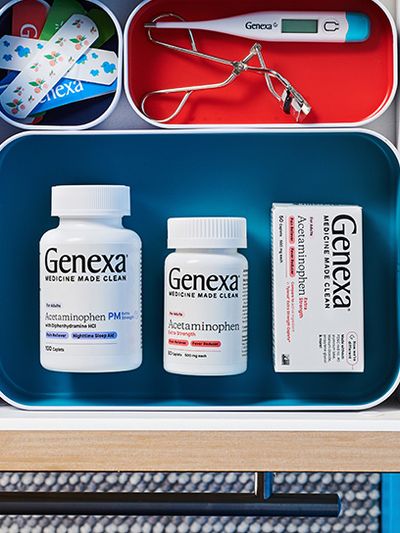How To Tell If Your Child Has A Sugar Headache
Sugar Headache: Symptoms, Causes, and Treatment
Written by Dr. Joel Warsh - Genexa Healthcare Provider & Partner on May 12, 2021
Have you ever felt a slight headache when you skip lunch for work and opt for a candy bar, or when you eat too much cake at a party? That’s a sugar headache. While you as an adult might know how to identify and avoid these uncomfortable issues, kids usually don’t.
Plus, kids love eating the most sugary foods and candies they can get their hands on. Chances are your kid will learn what a sugar headache is sooner or later, so let’s go over how to tell if your child has a sugar headache, plus explore some ways you can alleviate their symptoms.
What is a Sugar Headache?
Our bodies need a certain amount of “sugar” at all times to fuel our cells. While some people have natively high or low blood sugar levels, everyone has to maintain an optimal blood sugar concentration to feel good and avoid sugar headaches, plus other uncomfortable symptoms.
Sugar headaches happen when your blood sugar levels become unbalanced. You probably already know of some kinds of sugar headaches by another name: sugar crashes. For example, most kids love to eat sugary stuff, from cakes to cookies to ice cream, so their blood sugar levels sometimes become oversaturated and they crash a little while later.
While some kids escape sugar headaches, others aren’t so lucky. Adults can also experience sugar headaches if they aren’t careful with their diets. Sugar headaches happen when your blood sugar levels are either too high or too low, causing irritation to the blood vessels around your head and sinuses and hormone disruptions.
Low Blood Sugar vs. High Blood Sugar
Technically, there are two types of blood sugar imbalances: hypoglycemia and hyperglycemia.
Hypoglycemia means you don’t have enough sugar in your bloodstream. Specifically, you get hypoglycemia when your blood sugar levels go below 70 mg/dL. Adults experience hypoglycemia more often than kids since this condition is usually triggered by something like skipping a meal. Many adults do this on purpose to lose weight or because they have too much work to finish to feel like it’s okay to take a break.
However, triggering hypoglycemia on purpose can lead to a “sugar withdrawal” headache. In a nutshell, your brain normally produces extra dopamine when it gets a sudden boost of sugar. If your brain becomes used to certain levels of sugar, it will produce less dopamine when your sugar intake slows down.
Dopamine is the “feel good” hormone for humans. Once your body becomes used to a certain amount of it, a lower amount can make you feel bad, causing symptoms like fatigue, moodiness, and sadness.
Hyperglycemia is the opposite. It means you have too much sugar in your bloodstream. When this happens, your body can’t properly use that sugar with the available insulin in your bloodstream. You get hyperglycemia if your blood sugar levels go above 180 mg/dL.
When you get hyperglycemia, you might get a headache when your blood sugar levels spike and irritate the nerves around your head. You might also feel temporarily energized until you “crash” and lose that energy since your body will burn through it quickly.
Sugar Level Swings
In addition to hypoglycemia and hyperglycemia, you or your child might get a sugar headache just from the rapidly swinging sugar levels. When your blood glucose levels change rapidly, you can even get a "sugar hangover.”
These happen when your body burns through too much stored sugar in response to getting a bunch of extra sugar from what you eat or drink. You’ll feel lethargic and grumpy for a short while afterward.
Why Are Kids Vulnerable to Sugar Headaches?
Kids are uniquely vulnerable to sugar headaches for two reasons:
- They tend to eat sweeter foods than adults
- Any sweet foods they eat give their smaller bodies more sugar than they would proportionally give an adult body
Of course, sugar in this sense doesn’t always mean sugar as an ingredient in many sweets or desserts. Blood sugar is another term for your body’s glucose levels. You can have too much blood sugar, for instance, by eating too many fruits, eating too many carbs, and so on.
But kids usually get sugar headaches when they eat too many sweets in a short time frame. When this happens, their blood sugar levels spike and their energy levels usually rise with them. They might run around and go crazy for a little while before complaining of a headache. Fortunately, most kids also take a nap after the infamous "sugar crash.”
Other kids aren’t so lucky and might still feel the symptoms of a sugar headache after their crash. If that’s the case for your child, you might consider giving them some medicine to relieve their symptoms.
Genexa’s Kids’ Pain & Fever is real medicine, made clean, and is a powerful option to provide some relief from that headache the sugar has caused. It includes symptom-relieving active ingredient acetaminophen, without any artificial inactive ingredients, to help temporarily relieve some of the most common symptoms of sugar headaches, like pain near the temples or eyes.
Symptoms of Sugar Headaches to Watch For
Sugar headaches can be uncomfortable for both kids and adults. You can watch your child for certain symptoms to see if they are experiencing a sugar headache. This way, you’ll know when to give them good medicine for the symptoms and when to adjust their diets.
Symptoms to watch out for include:
- Headaches, of course. Sugar headaches will usually be focused around the eyes or temples.
- Nausea or vomiting. Any type of upset stomach might mean that your child accidentally ate too much sugar.
- Difficulty focusing or paying attention. General jitteriness sometimes means that your child has too much sugar and can’t focus their attention.
- Shakes or trembles. Sometimes sugar headaches can be accompanied by extra physical energy. Many kids show this extra energy as twitchiness.
- Lightheadedness or sudden fatigue. This is usually a precursor symptom to a sugar crash.
Fortunately, sugar headaches are usually mild and go away after an hour or two. The symptoms can be handled with medicine like our Pain & Fever offering and by ensuring that you or your child drink plenty of water.
Is a Sugar Headache Indicative of a Serious Condition?
Sometimes, but not always. If your child gets a sugar headache from eating a lot of cake at a birthday party, for instance, it’s probably not a sign of anything serious.
However, it is true that children with diabetes are uniquely vulnerable to sugar headaches. If your child has diabetes, they already have an increased risk for hypoglycemia or hyperglycemia depending on their diabetes type.
Therefore, if your child gets sugar headaches frequently, it might be a sign that they have undiagnosed diabetes. If you suspect diabetes, we’d recommend contacting your pediatrician and getting bloodwork done to check.
Summary
At the end of the day, most kids will experience sugar headaches at one time or another, just like adults do. But most kids will get sugar headaches from eating too much sugar instead of skipping a meal or trying out a new diet!
Still, it’s important to know the symptoms to watch out for and consider your medicine choices if you want to help alleviate your kid’s sugar headache symptoms.
Remember to try Genexa’s Pain & Fever medicine if you want a clean medicine (same active ingredients without artificial ones) that can help with sugar headaches and all kinds of common issues.
You can also check out Genexa’s other medicines to help with symptoms from coughs, colds, allergies, and more.





